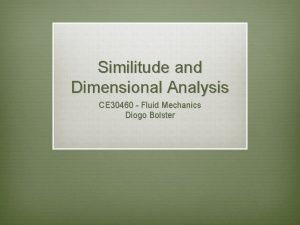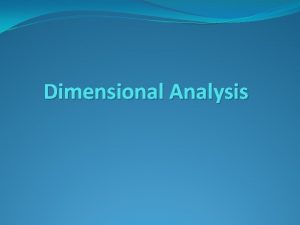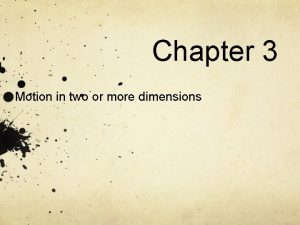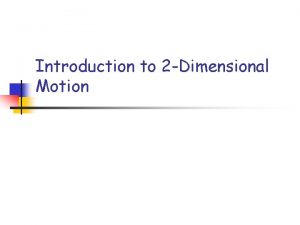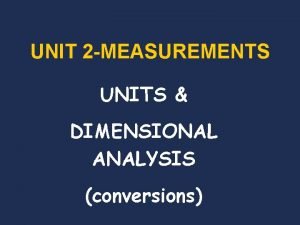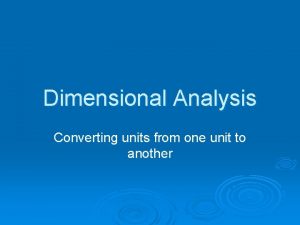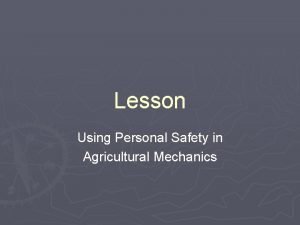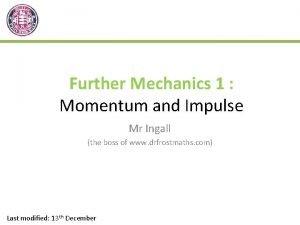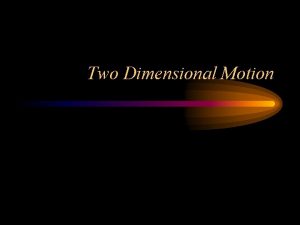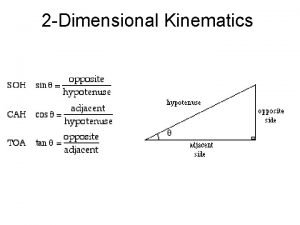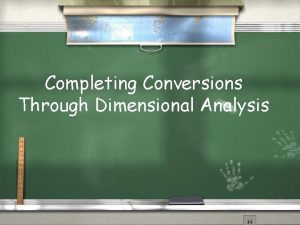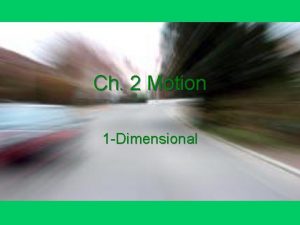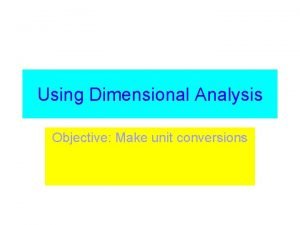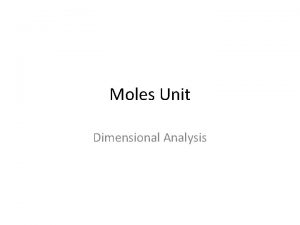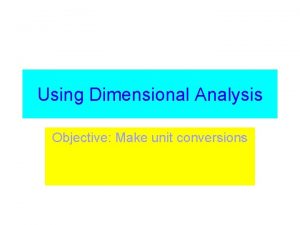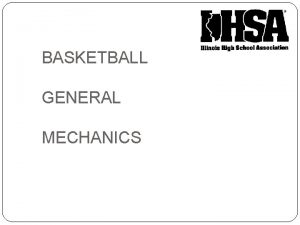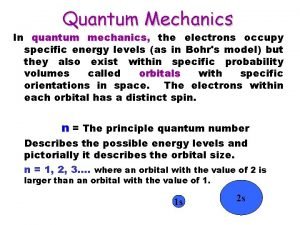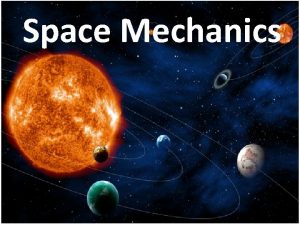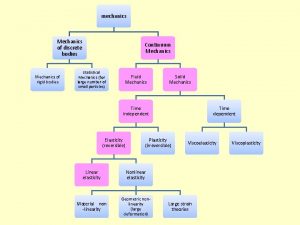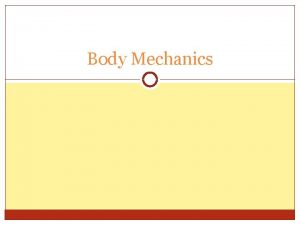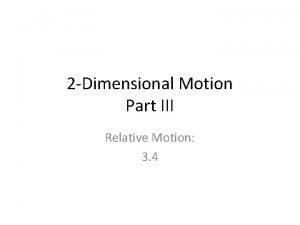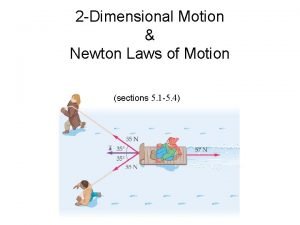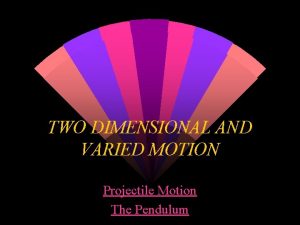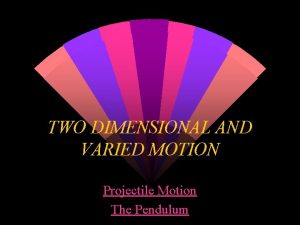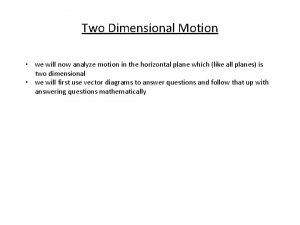Unit 2 1 Dimensional Motion Motion Mechanics the






































- Slides: 38

Unit 2 1 Dimensional Motion

Motion Mechanics – the study of how objects move and respond to external forces Kinematics – study of motion with no concern for the cause

Motion Perceiving motion is instinctive— your eyes pay more attention to moving objects than to stationary ones. Movement is all around you. Movement travels in many directions, such as the straight-line path of a bowling ball in a lane’s gutter, the curved path of a tether ball, the spiral of a falling kite, and the swirls of water circling a drain. When an object is in motion, its position changes. Its position can change along the path of a straight line, a circle, an arc, or a back-and-forth vibration.

Motion A description of motion relates to place and time. You must be able to answer the questions of where and when an object is positioned to describe its motion. In the figure below, the car has moved from point A to point B in a specific time period.

Particle Model

Relative Motion

Relative Motion

Relative Motion

Relative Motion

Relative Motion

Relative Motion

Relative Motion A) What is your speed relative to the ground? 100 km/h B) What is your speed relative to the seat you are sitting in? 0 km/h C) What is the speed of the fly relative to you? 0 km/h

Relative Motion

Coordinate System A coordinate system tells you the location of the zero point of the variable you are studying and the direction in which the values of the variable increase. The origin is the point at which both variables have the value zero.

Coordinate System In the example of the runner, the origin, represented by the zero end of the measuring tape, could be placed 5 m to the left of the tree. The motion is in a straight line, thus, your measuring tape should lie along that straight line. The straight line is an axis of the coordinate system.

Coordinate System You can indicate how far away an object is from the origin at a particular time on the simplified motion diagram by drawing an arrow from the origin to the point representing the object, as shown in the figure.

Coordinate System – define an origin and a positive direction Must remain consistent In one dimension Typically to the right is positive, left is negative

Coordinate System Position – a reference to the coordinate system


Coordinate System

Coordinate System

Vectors and Scalars

Vectors and Scalars

Vectors and Scalars Speed and Velocity. Speed is a scalar quantity. It only contains magnitude (number). Ex. 50 mph Velocity is the vector quantity. It contains both magnitude and direction. Ex. 50 mph N

Vectors and Scalars Distance and Displacement Distance is the total length traveled from beginning to end. It is a scalar quantity (magnitude only). Ex. 14 m Displacement is the position in reference to the origin. It is a vector quantity and includes both magnitude and direction. Ex. 14 m N

Vectors and Scalars Distance is 84. 5 m, displacement is 84. 5 m E.

Vectors and Scalars Distance traveled is 84. 5 m, displacement is 24. 5 m E.

Velocity







Velocity Average velocity Defined as the total distance over the total time Used when determining ETA by GPS; over long trips

Velocity Instantaneous Velocity at any instant in time. Measured by your speedometer in your car Used by police to issue tickets

Velocity Constant Velocity that is unchanging Speed of sound, speed of light, cruise control

Acceleration
 Circular motion is one dimensional or two dimensional
Circular motion is one dimensional or two dimensional Dimensional analysis fluid mechanics
Dimensional analysis fluid mechanics Dimensional analysis fluid mechanics
Dimensional analysis fluid mechanics Two dimensional motion and vectors
Two dimensional motion and vectors Two dimensional motion
Two dimensional motion Two dimensional motion definition
Two dimensional motion definition Dimensional analysis chemistry
Dimensional analysis chemistry Dimensional analysis converting one unit to another
Dimensional analysis converting one unit to another Unit 6 review questions
Unit 6 review questions Euler's differential equation
Euler's differential equation Shop safety color coding system
Shop safety color coding system Further mechanics 1 unit test 1 momentum and impulse
Further mechanics 1 unit test 1 momentum and impulse Chapter 14 using body mechanics
Chapter 14 using body mechanics Hát kết hợp bộ gõ cơ thể
Hát kết hợp bộ gõ cơ thể Frameset trong html5
Frameset trong html5 Bổ thể
Bổ thể Tỉ lệ cơ thể trẻ em
Tỉ lệ cơ thể trẻ em Chó sói
Chó sói Glasgow thang điểm
Glasgow thang điểm Alleluia hat len nguoi oi
Alleluia hat len nguoi oi Các môn thể thao bắt đầu bằng tiếng bóng
Các môn thể thao bắt đầu bằng tiếng bóng Thế nào là hệ số cao nhất
Thế nào là hệ số cao nhất Các châu lục và đại dương trên thế giới
Các châu lục và đại dương trên thế giới Cong thức tính động năng
Cong thức tính động năng Trời xanh đây là của chúng ta thể thơ
Trời xanh đây là của chúng ta thể thơ Mật thư anh em như thể tay chân
Mật thư anh em như thể tay chân 101012 bằng
101012 bằng Phản ứng thế ankan
Phản ứng thế ankan Các châu lục và đại dương trên thế giới
Các châu lục và đại dương trên thế giới Thơ thất ngôn tứ tuyệt đường luật
Thơ thất ngôn tứ tuyệt đường luật Quá trình desamine hóa có thể tạo ra
Quá trình desamine hóa có thể tạo ra Một số thể thơ truyền thống
Một số thể thơ truyền thống Cái miệng nó xinh thế
Cái miệng nó xinh thế Vẽ hình chiếu vuông góc của vật thể sau
Vẽ hình chiếu vuông góc của vật thể sau Nguyên nhân của sự mỏi cơ sinh 8
Nguyên nhân của sự mỏi cơ sinh 8 đặc điểm cơ thể của người tối cổ
đặc điểm cơ thể của người tối cổ Ví dụ về giọng cùng tên
Ví dụ về giọng cùng tên Vẽ hình chiếu đứng bằng cạnh của vật thể
Vẽ hình chiếu đứng bằng cạnh của vật thể Tia chieu sa te
Tia chieu sa te

